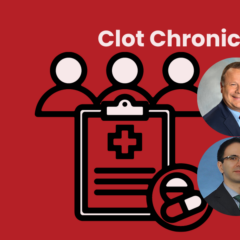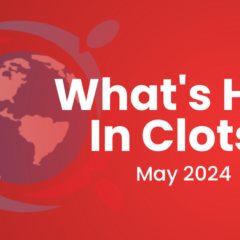Last updated on
Clot Chronicles: Inflammation and Thrombosis
Dr. Paul Ridker: Hi, I’m Dr. Paul Ridker, and I welcome you to this episode of Clot Chronicles. I want to thank Dr. Goldhaber for this opportunity to describe our research on inflammation in heart disease and inflammation in thrombosis to this exquisite audience.
I’m a cardiologist here at the Brigham and Women’s Hospital in Boston, and I work with Dr. Goldhaber. My own personal interests have been trying to understand what the root causes of atherosclerosis are, and what the root causes of thrombotic events are. We’ve learned that cholesterol plays a major part in this, and most of our patients with levels of thrombotic risk or heart disease are on cholesterol-lowering drugs.
But some 25 years ago, we learned that inflammation itself—the process by which the body heals injury—is also terribly important to the development of the thrombotic process. Many years ago, our group worked to develop a simple blood test—something called high-sensitivity C-reactive protein or hsCRP—and many patients now get this measure to figure out what their inflammatory risk is as compared to their cholesterol risk.
But more recently, we’ve been able to ask the question of in addition to lowering your cholesterol and to lower your risk of having a thrombotic event, what can we do that’s actually anti-inflammatory? So, my research group, over the last 8-10 years, designed two parallel clinical trials both asking the questions 1) can we reduce inflammation? and 2) would that reduce the risk of having a clot/thrombotic event?
The first of those two studies is something called CANTOS—it’s a mouthful—the Canakinumab Anti-inflammatory Thrombosis Outcome Study. But what it really was was a proof of principle. A large, 10,000-patient trial done all over the world where patients who’d had a prior heart attack were randomized to get either a placebo or a very novel drug that blocks a very specific pathway of inflammation—something called interleukin-1β (but that’s not very important)—and that pathway specifically leads to a reduction in other cytokines and, ultimately, a reduction in the CRP itself. But it has no effect on cholesterol and no effect on blood pressure and no effect on diabetes and things like that.
And the bottom line of that trial was that many years later, those people who received this novel drug had a 15-17% reduction in ever having another heart attack, another stroke, or dying of cardiovascular disease without changing their cholesterol at all. And that’s very exciting and very interesting because it proves that altering inflammation can also reduce the risk of having these thrombotic events.
Now in the perverse way that science sometimes works, we made a second discovery that actually has changed the way this particular drug will be available to patients. In the same study, we actually showed that the drug reduced the risk of ever getting a certain kind of lung cancer by almost 75%. And so, for better or for worse, this drug is being repositioned now as a cancer drug. So, in this atherosclerosis study, we discovered something very, very important.
Now at the same time as CANTOS, we were doing another clinical trial funded by the National Institutes of Health called the Cardiovascular Inflammation Reduction Trial (CIRT). And, in fact, Dr. Goldhaber and his team were the number one recruiters for this trial in the United States. And that trial used a very simple, generic anti-inflammatory drug called methotrexate—low-dose methotrexate—that’s routinely used to treat rheumatoid arthritis.
But science is quite complicated, because what we learned from CIRT was that this common drug that’s effective for treating arthritis did not lower this critical access of interleukin-1 to interleukin-6 to interleukin CRP. And, perhaps, because it had no effect there, it actually had no effect on heart attacks or strokes either. But we don’t look at this as a negative study, we look at it as an informative neutral study. Between the positive data of CANTOS and the neutral data from CIRT, we now know exactly what the target is in the future to figure out how to lower inflammation and lower cardiovascular disease.
So I guess the real question is where’s the field going? Well, there’s many different things going on here. The most important clinically is that my colleagues and internists around the world now recognize two different concepts: 1) residual cholesterol risk (that is to say the cholesterol levels need to come down further), and 2) residual inflammatory risk. By measuring both the LDL cholesterol and the CRP, we can figure out which problem our patients have. It’s a concept called personalized medicine. How do we get the right drug to the right patient at the right time? Well, the first step is to figure out what the underlying biologic problem my individual patient (sitting in front of me in clinic) actually has. We’re past that; we now know how to do that.
The second step becomes what kinds of agents might we use that are anti-inflammatory? Well, I’ve said earlier that this canakinumab is being repurposed as a cancer drug, so that won’t be available. My group and others around the world are taking this proof of principle, however, and trying to figure out if there are other agents that we can now use to get a similar effect in randomized trials, which are ongoing for the next 5-7 years.
And there’s actually a great deal you can do today about this. Interestingly enough, standard mom and pop things! Diet, exercise, and smoking cessation all turn out to lower CRP; they all turn out to be anti-inflammatory, and they all (we know) lower cardiovascular event rates. So, I would say that if you have an elevated CRP, go to the gym, put some sneakers on, throw out the cigarettes, and try to eat a healthier diet. All of that is good for you, and all of that will reduce the risk of thrombosis.
So again, I want to thank Dr. Goldhaber for the opportunity to present this information today for Clot Chronicles. I wish all of you a healthy life and hope you learn more about this disease and what goes on in the research center here at the Brigham.



